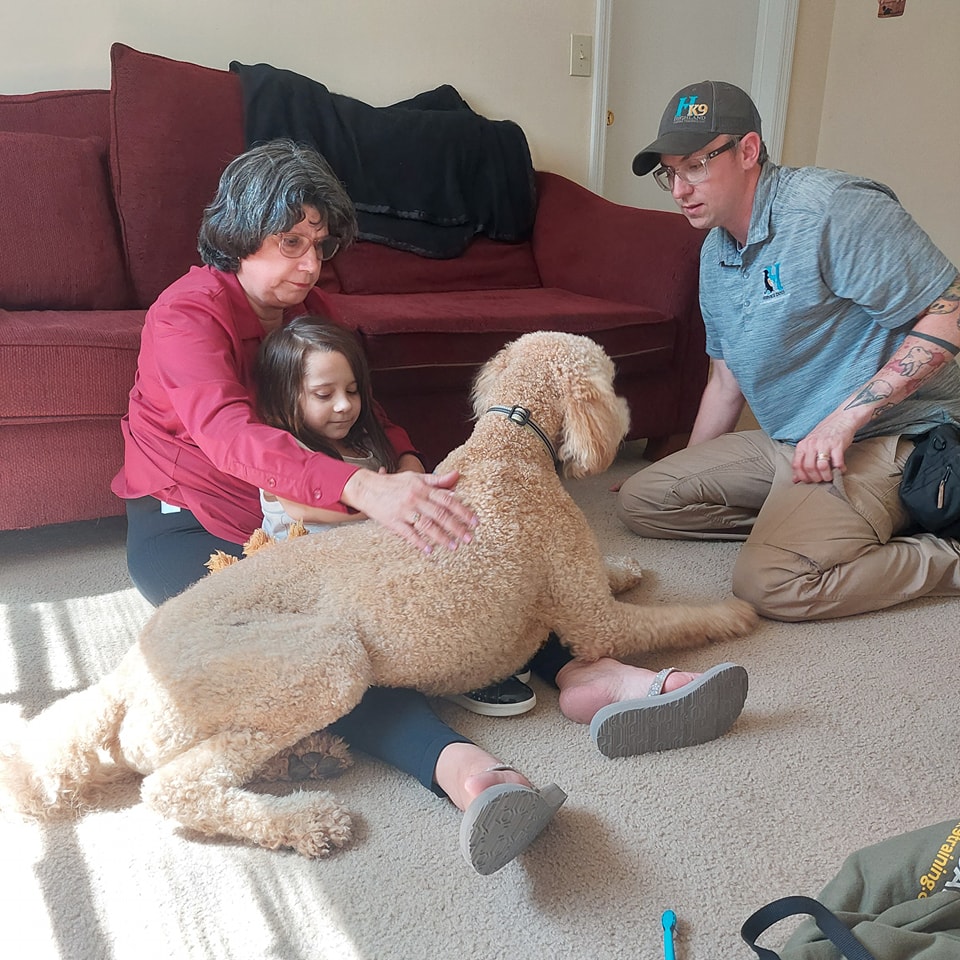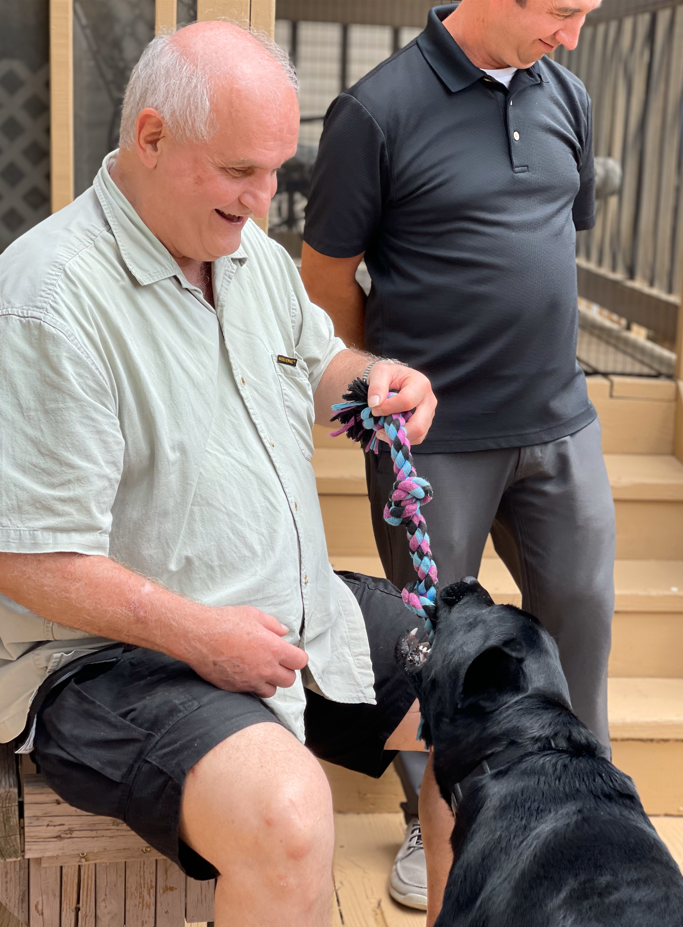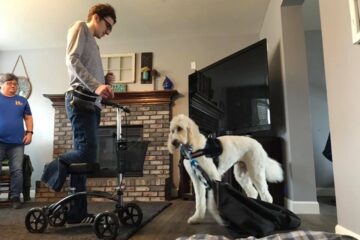Service dog deliveries are a very poignant event. For our service dog team, delivery marks the end of several months of preparation and intensive training; for the service dog handler, it marks the beginning of an improved quality of life alongside their four-legged partner.
At Highland Canine Service Dogs, we place a huge emphasis on the delivery aspect of our service dog training program. This is the culmination of the countless hours of work and dedication that our trainers put into working with each of our fully-trained service dogs. Over the years, we have received positive feedback from our service dog recipients regarding just how valuable the delivery part of our training program was for them.
To give you an insight into our service dog delivery process, we spoke with Emma Stowe. Emma is Highland Canine Training’s pet dog trainer covering Cleveland, OH and the surrounding areas. She has also played a role in the training of our service dogs, and helping deliver them to their handler. Emma’s insight will help you to understand why the delivery is so important, and what to expect when a service dog is delivered to your family through Highland Canine Service Dogs.
Emma, why is the service dog delivery an important part of Highland Canine's service dog training process?
Service dog deliveries are critical to the final stages of the service dog’s training. The transition period for a dog to be moved into an entirely new environment and routine can be stressful, for both the dog and their new family.
During the delivery time we are polishing the training of the service dog to perform all their known tasks for their new child or handler, but more importantly, we are teaching the family. A lot of families that receive a service dog have never had a dog before, so our focus as service dog trainers is teaching this new family how to handle the dog through obedience, doing tasks, and even just adjusting to their new routine of owning a dog.
The first day is the most stressful for everyone. As a trainer, we are excited to reintroduce the dog to their family, and we immediately start with building the bond between dog and handler or child. The difference between the handler or the child is an important distinction because a majority of our dogs are trained for autism assistance, and in this scenario the handler is not always the person the dog needs to bond with. Building the bond is the top priority so that there are fewer, if any, confusions for the dog on who they provide tasks to.
Bonding also helps a lot of the children build confidence in themselves by developing new routines that they can accomplish on their own – for example, feeding the dog dinner, playing ball with them, or even just grabbing a handful of treats to feed them on their own. Even though we start these routines on day one, the bonding process can take a few months for some children to fully develop the love for their new service dog.
The delivery process also allows trainers to make important tweaks to the final skillset of the dog. Basic tasks that we teach include tactile stimulation, deep pressure therapy and tethering. Tactile stimulation, also referred to as “touch,” is commonly used to disrupt stimming that may develop into self-injurious behavior or a meltdown. “Touch” is taught to our service dogs with a generalized location of the leg, but during our delivery process we can change this location on the child or handler if they prefer the dog to “touch” another part of the body, like their chest or back for example. Deep pressure therapy, also called “lay,” can be adjusted as well if the child doesn’t like pressure on their stomach to having the dog lay on their feet.
It’s these adjustments that make a delivery so important, because preferences may change after the time of a match to the point of delivery.
Training the family is the biggest piece of the puzzle. Within four days, we are there to make sure everyone handling the dog is confident in themselves and their new partner. The thought of training a dog and then not teaching the family is irresponsible. Service dogs are not robots, they are individual animals that require consistency and clear communication. Some families have experience setting boundaries with dogs in the house, while others need these guidelines created with them.

What are the benefits of delivering a service dog to the handler's home?
The main benefit of delivering a dog to the family is allowing us as trainers to be a part of their daily routine. Before delivery, we ask for a schedule of daily activities or locations that they frequent as a family so we can incorporate as much normalcy in the short time frame.
As a part of deliveries, we bring a place bed for the dog, and we can help the family find the best place in the house to create a spot for their new dog. We can also help them decide where the best place to feed their service dog is, and incorporate the dog into household routines like keeping the dog on their place bed while the family eats, or putting them in the kennel during bath time.
Teaching the family how to incorporate the dog into their life while in a setting where everyone is comfortable reduces the stress on the family during this transition period – and on the dog. Compare this with a scenario where the family were to come to Highland’s facility and pick the dog up – everyone would be on edge a little bit, because they’re living in a hotel for four days and trying to learn everything about their service dog. By taking the stress of travel off of the family, we can help them have a much smoother transition. The dog is able to settle into their new home faster, figuring out where they eat, sleep and go to the bathroom.
It’s also less stressful on the dog because they are only uprooted once from our facility to their new home, instead of adding in an awkward transition into a hotel, and then uprooting them again into their forever home. And for children or adults with autism, seizures or hearing deficiencies, it is more beneficial to stay in the environment where they are comfortable, and the dog will be doing their job in these environments more frequently than anywhere else.
Can you outline what families can expect from service dog deliveries?
Deliveries are going to be stressful, but they will be successful!
The service dog trainers will have a plan, and a rough schedule. Personally, my schedule is based around the goals I want to accomplish with the family each day rather than a schedule for every minute of the day. Some people are “natural” dog handlers and pick up the basics within an hour, while others could take a few hours to really build their confidence in working with the dog.
Usually, deliveries are 4-5 days, depending on the tasks that the dog is trained for and the family’s lifestyle. Day one is focused on building the bond between dog and the family, emphasizing the bond between the dog and the child or adult that the dog is trained to work with. As a trainer, my goal is to get the primary handler (in the case of children that are unable to handle the dog themselves, this would be the parents or guardians) comfortable walking the dog and working all their obedience together on day one. I would also like to introduce one or two of the tasks that the dog knows so we can begin setting up training plans from that first day.

Every delivery is different, because each family has different needs and we are going to tailor each day to the family. Days two through four (or five) are heavily focused on task practice and outings to ensure that everyone that will be handling the dog is comfortable walking with the dog in public and using their tasks when necessary. We try to do at least one outing each day – this could include going to the grocery store, going out to eat, or going to a favorite park. Task practice will take place in the house and in public, which is especially important for seizure response dogs.
One of our service dogs, June (a seizure response dog), who was delivered in February, performs her tasks mainly in the home or when her handler goes out to eat. During this delivery, we spent half-days working in the house and the other half working in public. A signal alert dog, Bella, delivered in July, only has tasks that are done inside the house. Johnny, an autism assistance dog delivered earlier in the summer, had tasks like Touch and Lay focused mainly in the home but heavily emphasized Tethering while out in public.
Each day is going to involve a little bit of problem solving and sometimes “winging it” to ensure the family has enough time to focus on what they need to learn. Everything doesn’t always go according to plan, and unfortunately, there are times when the original schedule has to get thrown out the window. But being in the home with the whole family makes changing the whole day a little bit easier. For example, Autism Service Dog deliveries can be challenging if the child has a difficult time bonding with the dog, but we can use those moments to best teach the parents how to handle in a difficult situation, or if needed a trainer can replace the child so that the parents get practice sending the dog.
We don’t let these hiccups discourage the family because one day they will have to problem solve after the delivery, so we use these situations to make sure everyone is ready.

Is there anything service dog handlers need to do after the delivery to ensure their service dog continues to perform reliably?
Keep up with your maintenance training! When clients receive a service dog, the dog is fully-trained, but if families fall behind in practice the dog won’t be reliable in their tasks or obedience. As I mentioned before, service dogs are not robots, so if we give them a break from consistency, they can regress in the training they have had.
Our typical recommendation is to practice each task the dog has learned at a minimum of three times per week, and obedience should be practiced every day. Stay consistent! After the trainers leave a delivery, it is important to continue the consistent expectations with your service dog that you learned. Create a schedule for yourself to incorporate your training daily.
Always reach out to your trainer if you have any questions! The delivery is not our final goodbye – we are always here to help if you have any questions about new behaviors that arise or changes to your daily routine, and how to integrate your service dog into that.
As a trainer, can you summarize how rewarding being a part of this process is?
Training a service dog is more than just training a dog to always have the best obedience and perform their tasks reliably. It’s about creating a bond with a dog, knowing that they are going to change someone’s life. I wanted to be a service dog trainer because I love dogs and I want to help people. Being a part of the journey to bring independence and confidence to people through dogs is a fulfilling experience. These dogs are more than just emotional support to people with disabilities – they become a source of security and safety.
Knowing that we are bringing someone an exceptional service dog to allow them a life that is otherwise difficult or impossible makes even the most heart-wrenching goodbyes worth it. Whether they enter our program at 8 weeks or 12 months, we love these dogs, and are bonded to them as much as they will be with their new family. Seeing them grow up and working through any quirks, like being mortified by traffic cones to not even giving them a second glance, is one that I would never give up. Because in the end, I know that all the love I have put into this dog is going to be given ten times more to them from their handler.
The first day of delivery is the hardest as a trainer, because that’s the day that we truly say goodbye to our best friend and the dog says hello to their permanent one. Seeing that bond develop and watching them work with their new partner is heartwarming, because that dog is prepared for anything that may come its way in the future.
By the end of delivery, we know that the dog no longer needs us, and that gives us the ability to do it all over again.



0 Comments